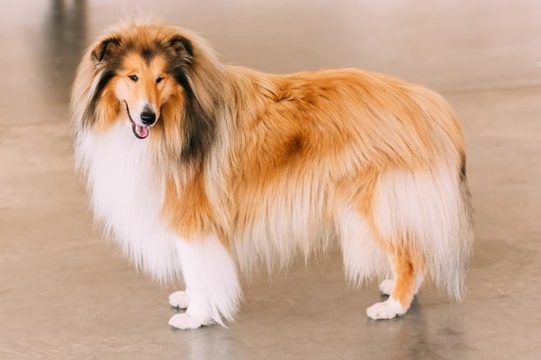Pets
Pets for studWanted petsBreedersAccessories & services
Knowledge hub
Support
Support & safety portal
Rough collie hereditary health and health testing
The rough collie is perhaps better known colloquially as the “Lassie” dog, having achieved fame as the breed used within the popular TV show that many of us remember from our childhoods. They are a medium to large sized breed that has a very long, dense and thick coat, and which was originally bred in Scotland as a herding dog. They share a lot of physical similarities with various other collie breeds, including the Shetland sheepdog, which is actually partially descended from the rough collie breed.
While the dog is actually medium to large in size, they often appear much larger due to the sheer thickness and volume of their coats. Males of the breed can stand up to 26” tall at the withers, and weigh up to 34kg. Females tend to be slightly smaller.
The coat of dogs of the breed require a significant of grooming and brushing in order to keep it in good condition, with care taken to get right down to the dense undercoat. Dogs of the breed can be found in a wide variety of colours including tricolour, sable, merle, double merle and mahogany sable, as well as various variants of these shades too.
If you aspire to owning a rough collie and think you have what it takes to keep up with their necessary coat maintenance, it is wise to do plenty of research into other aspects of the breed too, such as their health and any recommended health testing. We will cover these factors in more detail in this article.
Rough collie longevity
The average lifespan of the rough collie is 12-15 years, which places them towards the average to high end of the age range across the board for all breeds of a similar size and build.
Rough collie genetic diversity
The coefficient of inbreeding statistic for the rough collie is 14.3%, which is well above the 6.25% or lower that is considered to be the ideal for all pedigree dog breeds. This indicates that the breed is subjected to a significant amount of inbreeding in order to keep breed lines viable, and rough collie breeders are advised to reduce the coefficient of inbreeding statistic within their own breed lines where possible.
Conformation
The sheer length, density and layers of the rough collie’s coat means that they may have problems keeping their cool in hot weather, and maintaining a low enough body temperature. Care should be taken in hot weather to ensure that dogs of the breed have access to a shaded area, and plenty of water in order to cool themselves down with.
Health testing for the rough collie
The British Veterinary Association and The Kennel Club advises that dogs of the breed are tested for certain hereditary health conditions prevalent within the breed prior to mating. This allows breeders to make an informed decision on whether or not to breed their dogs, and helps to improve hereditary health across the breed as a whole.
Testing schemes in place for the breed are:
- Hip score testing, with the breed’s mean hip score being 9.2.
- Elbow score testing, with the ideal being zero.
- Eye testing for multifocal retinal dysplasia, collie eye anomaly, and progressive retinal atrophy.
- Testing for retinal pigment epithelial dystrophy.
DNA tests available for the breed are:
- Choroidal hypoplasia and collie eye anomaly.
- Multi-drug resistance.
- Degenerative myelopathy.
- Generalised progressive retinal atrophy.
- The merle gene test.
- Canine cyclic neutropenia, or grey collie syndrome.
Other health issues
As you can see, the rough collie is potentially prone to a range of health pitfalls with a hereditary element to them, but many of these can be screened for prior to breeding. As well as the testable conditions listed above, the rough collie is also considered to have slightly elevated risk factors for the following health problems too:
- Various types of cancers, with cancer being one of the leading causes of death in dogs of the breed. Skin cancers and stomach cancers are the most common.
- Idiopathic epilepsy, a seizure disorder.
- Entropion of the eyelids, which causes them to tilt inwards and rub on the cornea.
- Corneal dystrophy, in which the cornea of the eye becomes displaced.
- Pyometra in un-neutered female dogs, particularly older dogs of the breed.
- Renal amyloidosis, a kidney disorder.
- An autoimmune disease called cutaneous lupus erythematosus, a condition that leads to the formation of scales on the face, and a loss of skin pigment.
- Various different types of dermatitis.
- A particular sensitivity to certain drugs and medications, particularly Ivermectin.
- Pancreatitis.
- Exocrine pancreatic insufficiency, which leads to a range of problems including chronic hunger, weight loss, poor digestion, and diarrhoea.
- Haemophilia, a blood clotting disorder.
- Carpal hyperextension syndrome, a problem with the ligaments of the wrist joints that causes lameness and pain.
- The potential for deafness in dogs of the breed that are merle coloured, and particularly in double merle dogs.



